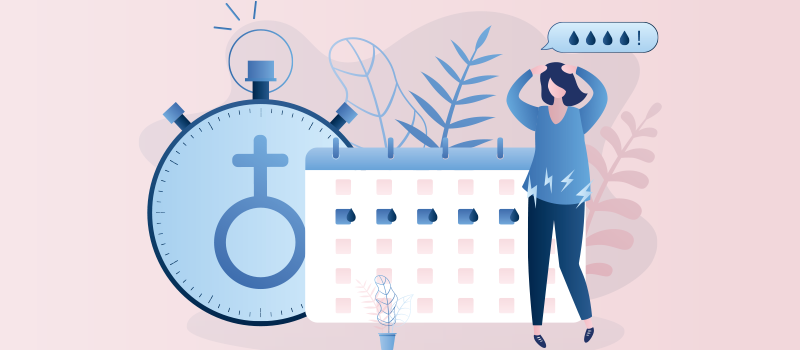Low Progesterone Symptoms & Treatment

Estrogen and progesterone are female sex hormones that play important roles in the body. Progesterone is needed to regulate the menstrual cycle and support a healthy pregnancy. Low progesterone levels can cause a range of severe symptoms in women and people assigned female at birth. Progesterone supplements are available in the form of suppositories, pills, and injections to treat low progesterone. If you suspect you do not have enough progesterone, please continue reading to learn what happens when progesterone levels drop. We will also talk about how to address low progesterone symptoms.
What is progesterone?
Progesterone is a sex hormone that the ovaries produce with support from the adrenal glands. Progesterone plays an important role in women’s reproductive health. Normal progesterone levels are needed to support menstruation and maintain early pregnancy. Some of the roles progesterone plays in the body include:
- Maintaining a normal menstrual cycle and bleeding during menstruation
- Thickening the uterine lining during the luteal phase of the menstrual cycle to prepare it for a fertilized egg to get attached
- Supporting the developing embryo after conception
- Preventing uterine contractions to prevent preterm labor
- Preparing the breasts for milk production after childbirth
- Improving mood
- Facilitating the action of thyroid hormone
Low progesterone levels can cause irregular periods, mood changes, problems conceiving, and difficulty maintaining a pregnancy.
What are normal progesterone levels?
Progesterone levels fluctuate throughout the menstrual cycle and reach high levels during pregnancy. They are less than 2 nanograms per milliliter (ng/mL) during the first half of the menstrual cycle (follicular phase) and around 20 ng/mL during the second half of the menstrual cycle (luteal phase or about one week after ovulation).
If no pregnancy occurs, progesterone levels drop, and you get your period. If you conceive, progesterone rises. Levels of progesterone are around 90 ng/mL during the first trimester of pregnancy and as high as 300 ng/mL by the third trimester (even higher if it is a multiple pregnancy). Progesterone levels can fall to under 0.5 ng/mL in postmenopausal women.
What is the main cause of low progesterone?
Some of the causes of low progesterone include:
- Anovulation (when the ovary does not release an egg and ovulation does not happen).
- Polycystic ovarian syndrome (PCOS) - a condition in which hormone imbalance leads to the formation of small cysts in the ovaries, irregular ovulation, and missed periods.
- Low cholesterol.
- Chronic stress and high levels of cortisol (stress hormone).
- Extreme stress on the body due to over-exercising or severe dieting.
- Hypothyroidism (underactive thyroid gland).
- Hyperprolactinemia or high prolactin levels (this hormone is responsible for milk production).
- Declining progesterone levels during perimenopause (around the time of menopause).
- Genetic Factors
What are the signs of low progesterone?
Signs and symptoms of low progesterone include:
- Irregular menstrual cycles (irregular or absent periods).
- Difficulty conceiving.
- Headaches.
- Mood swings, anxiety, depression.
- Sleep problems.
- Hot flashes.
- Bloating and weight gain.
- Pregnancy complications such as ectopic pregnancy (this is when the fertilized egg implants outside the uterus, usually in the fallopian tube).
- Difficulty staying pregnant (increased risk of miscarriage and preterm labor).
- Light spotting, fatigue, breast tenderness, and low blood sugar during pregnancy.
- Symptoms such as heavy menstrual bleeding, weight gain, low libido (decreased sex drive), and gallbladder problems due to hormonal imbalance, specifically estrogen dominance (low progesterone and high estrogen levels).
How to check if I have low progesterone?
You cannot test progesterone levels at home. Your doctor can do a blood test (progesterone test) to measure progesterone levels.
How do you fix low progesterone?
Progesterone supplementation is available in the form of progesterone suppositories, oral progesterone pills, and progesterone shots (injections).
Progesterone treatment is prescribed to increase hormone levels depending on your goals. For example, if you are having difficulty getting pregnant due to luteal phase deficiency of progesterone, hormone therapy can help to thicken your uterine lining. During menopause, when estrogen and progesterone levels fall, hormone replacement therapy can help manage menopausal symptoms such as hot flashes and night sweats.
How can I increase my progesterone levels?
Natural ways to maintain normal levels of progesterone include getting regular exercise and eating a healthy diet that includes vitamin B, vitamin C, zinc, and magnesium. It is also important to manage stress levels and get enough sleep.
Bioidentical hormones (plant-based hormones that mimic natural reproductive hormones) can be used to treat low progesterone levels. However, you should only take them under medical supervision.
Seek professional medical advice if you suspect you have signs of low progesterone. In particular, do not delay seeing your doctor if you have symptoms such as abnormal uterine bleeding (vaginal bleeding between periods).
References:












SOCIAL